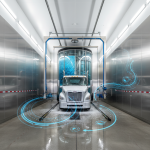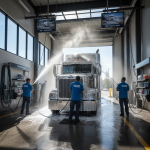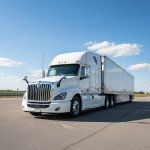In the fast-paced world of last mile delivery, there is a hidden battle that rages on behind the scenes. It’s not just about getting packages from point A to point B; it’s about the constant struggle against the elements – dirt and grime. Delivery drivers face the challenge of keeping their vehicles and packages clean, despite the inevitable messiness of the road.
Whether it’s muddy roads, dusty warehouses, or even unexpected spills, these hardworking individuals are constantly fighting a losing battle against the forces of nature. But why does this matter? Isn’t it just dirt and grime?
The answer lies in customer satisfaction. Last mile delivery represents the final touchpoint between businesses and their customers. And if packages arrive looking dirty and worn, it leaves a negative impression. Customers may question the professionalism and quality of the brand, leading to potential loss of trust and future business.
In this article, we delve into the hidden side of last mile delivery and explore the strategies and technologies used to combat dirt and grime. From advanced vehicle care to innovative packaging solutions, companies are finding ways to ensure that every package arrives pristine, despite the constant battle against nature.
The importance of cleanliness in last mile delivery
Cleanliness may seem like a trivial aspect of last mile delivery, but it plays a crucial role in the overall customer experience. When a package arrives at a customer’s doorstep, it is a reflection of the brand’s commitment to quality and attention to detail. A dirty or damaged package can create a negative impression, diminishing the value of the product and the brand as a whole.
Moreover, cleanliness is not just about aesthetics; it also has practical implications. Dirt and grime can compromise the integrity of the packaging, leading to potential damage to the contents inside. This can result in returns, refunds, and additional costs for the business. By prioritizing cleanliness, companies can ensure that their packages arrive in optimal condition, minimizing the risk of customer dissatisfaction and financial losses.
Challenges of maintaining cleanliness in last mile delivery
Maintaining cleanliness in last mile delivery is no easy feat. Delivery drivers face numerous challenges on a daily basis that make it difficult to keep their vehicles and packages clean. One of the primary challenges is the unpredictable nature of the road. From muddy rural roads to congested city streets, drivers encounter various conditions that contribute to the accumulation of dirt and grime.
In addition to road conditions, delivery drivers also have to navigate through dusty warehouses and loading docks, further exposing packages to potential dirt and debris. Furthermore, unexpected spills and accidents can occur during transit, causing additional mess and damage. All these challenges combined make it an uphill battle for delivery drivers to maintain cleanliness throughout the last mile.
The impact of dirt and grime on last mile delivery
The impact of dirt and grime on last mile delivery goes beyond superficial aesthetics. As mentioned earlier, a dirty package can leave a negative impression on the customer, potentially damaging the brand’s reputation. In an era where online reviews and word-of-mouth recommendations hold significant weight, customer satisfaction is paramount.
Customers expect their packages to arrive in pristine condition, and any signs of dirt or grime can erode their trust in the brand. This can lead to negative reviews, reduced repeat business, and even a decline in brand loyalty. Therefore, businesses must recognize the importance of combating dirt and grime in last mile delivery to maintain a positive customer experience and protect their brand image.
Strategies for combating dirt and grime in last mile delivery
To combat dirt and grime in last mile delivery, companies are implementing various strategies and technologies. One of the most effective strategies is investing in advanced vehicle care. This includes regular cleaning and maintenance of delivery vehicles to prevent the accumulation of dirt and grime. By keeping the vehicles clean, companies can ensure that packages are transported in a clean and hygienic environment.
Another strategy is the use of innovative packaging solutions. Companies are investing in durable and dirt-resistant packaging materials that can withstand the rigors of the last mile. Additionally, some companies are exploring the use of protective coatings and films to create an additional barrier against dirt and grime. These packaging solutions not only protect the contents of the package but also enhance the overall customer experience.
Best practices for maintaining cleanliness in last mile delivery
Maintaining cleanliness in last mile delivery requires a proactive approach and adherence to best practices. Firstly, companies should provide proper training and resources to their delivery drivers to ensure they understand the importance of cleanliness and have the necessary tools to maintain it. This includes providing cleaning supplies, such as wipes and sprays, for on-the-go cleaning.
Secondly, companies should establish clear guidelines and protocols for cleanliness. This includes regular vehicle inspections, scheduled cleaning routines, and accountability measures for drivers. By setting clear expectations and providing support, companies can foster a culture of cleanliness and ensure that every package is delivered in its best possible condition.
The role of technology in improving cleanliness in last mile delivery
Technology plays a significant role in improving cleanliness in last mile delivery. Companies are leveraging advancements in vehicle tracking and routing systems to optimize delivery routes and minimize exposure to dirty or hazardous areas. Additionally, some companies are exploring the use of automated vehicle washing systems, which can efficiently clean delivery vehicles without the need for manual labor.
Furthermore, technology is being used to develop innovative packaging solutions. For example, some companies are experimenting with self-cleaning packaging materials that repel dirt and grime. These materials use nanotechnology to create a protective barrier that prevents dirt particles from adhering to the surface. By harnessing the power of technology, companies can enhance cleanliness in last mile delivery and elevate the customer experience.
Case studies: Successful examples of cleanliness practices in last mile delivery
Several companies have successfully implemented cleanliness practices in their last mile delivery operations. One such example is a leading e-commerce giant that invests heavily in vehicle care and maintenance. They have a dedicated team of technicians who regularly clean and inspect their delivery vehicles to ensure optimal cleanliness. This commitment to cleanliness has resulted in positive customer feedback and increased brand loyalty.
Another example is a logistics company that has implemented comprehensive training programs for their delivery drivers. They conduct regular workshops on cleanliness practices and provide drivers with cleaning kits to maintain cleanliness on the go. By prioritizing driver training and support, they have seen a significant reduction in customer complaints related to dirt and grime.
Future trends in last mile delivery cleanliness
As the last mile delivery industry continues to evolve, so too will the strategies and technologies used to combat dirt and grime. In the future, we can expect to see further advancements in vehicle care, such as self-cleaning vehicles equipped with innovative cleaning systems. Additionally, the development of dirt-resistant and self-cleaning packaging materials will revolutionize the way packages are protected during transit.
Furthermore, the integration of artificial intelligence and machine learning algorithms will enable companies to optimize delivery routes based on cleanliness factors. This will ensure that packages are transported through the cleanest and safest routes, minimizing exposure to dirt and grime. The future of last mile delivery cleanliness is bright, with technology playing a pivotal role in improving the customer experience.
Conclusion: The key to successful last mile delivery – cleanliness
In conclusion, cleanliness is a crucial aspect of last mile delivery that should not be overlooked. It impacts customer satisfaction, brand reputation, and financial performance. Companies must recognize the importance of combating dirt and grime and implement strategies and technologies to maintain cleanliness throughout the last mile. By prioritizing cleanliness, businesses can leave a positive impression on their customers and ensure that every package arrives in optimal condition. Ultimately, cleanliness is the key to successful last mile delivery.




